Artists now restoring downtown ‘Aztec Calendar’ mural
Hispanic murals documents Chicano legacy and preserves ethnic history
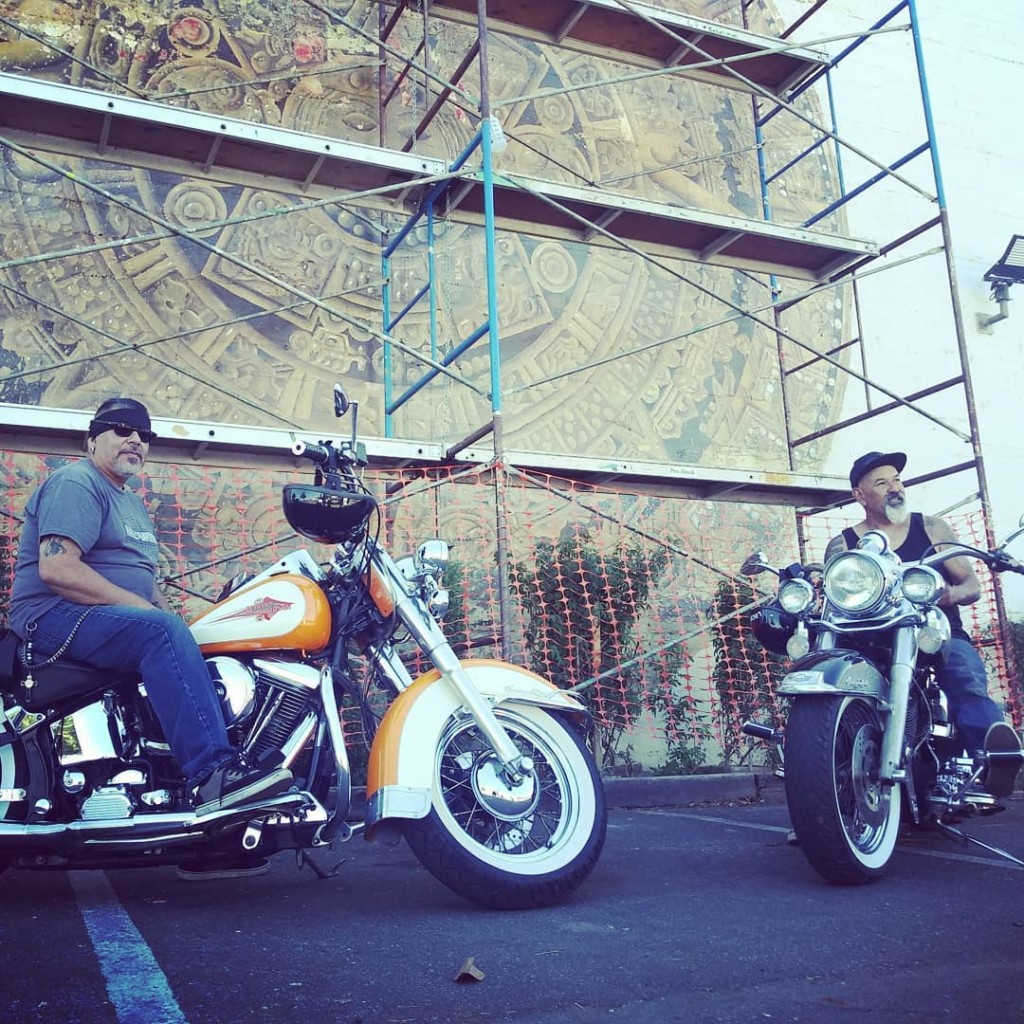
Photo courtesy Cesar Gamboa
Original artists Jimmy Castañeda and Dimas in front of the mural.
By Vanessa Soto
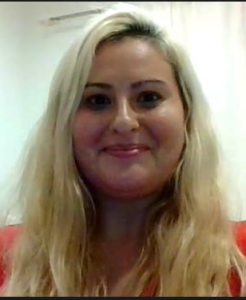
Vanessa Soto
Since 1978, the immense “Aztec Calendar” mural on a downtown Gilroy building has served as a source of pride for the Mexican-American community. Unfortunately, during the decades the original bright colors have faded. Recently, a group of local volunteers have been hard at work in an effort to bring this public artwork back to life.
The official title of the mural is La Piedra del Sol (The Sun Stone) and it fills a space 25 feet by 75 feet. The original artists in the 1970s were part of a youth empowerment program known as Tecolote (Owl), a project that gave the farm-worker youth an opportunity to become more civically engaged in Gilroy. Many of the original artists as adults in 2020 are enthusiastic about the restoration.
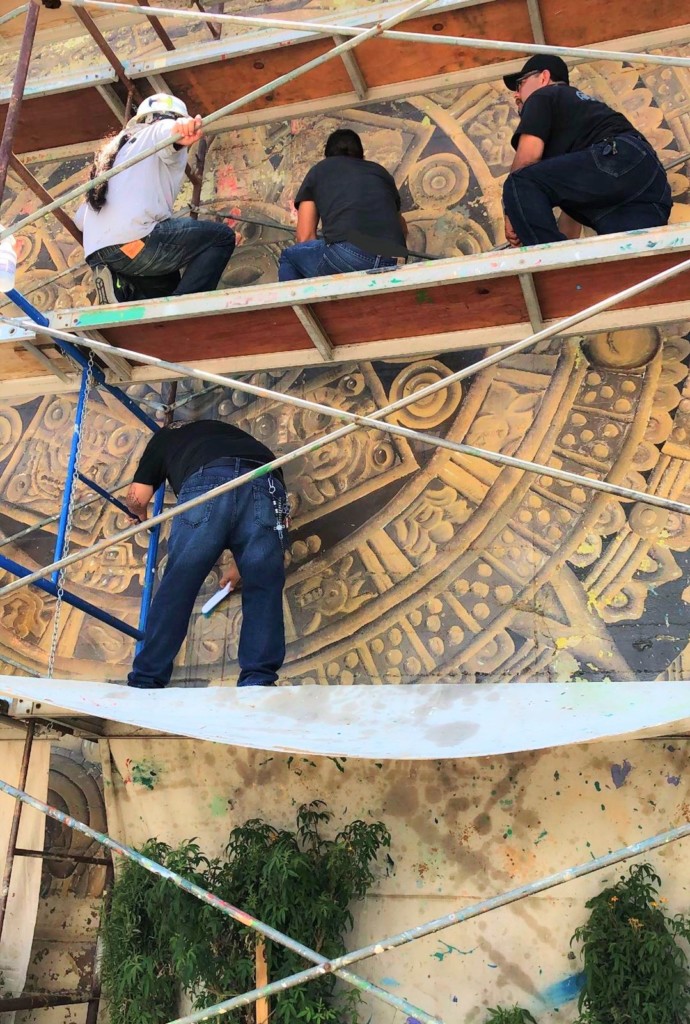
Photo courtesy Cesar Gamboa — Hector Villegas, Jose Sanchez, Sal Olguin, and Pete Dimas work on the mural.
“I feel excited, I feel good because I’m surprised it lasted this long,” said Salvador Holguín, one of the original artists. “I know it’s been damaged before, but I just can’t wait to get it back to the way it was.”
The proposed sketch of the revitalized mural includes the original Aztec calendar in the center, but will include additions of two classic lowriders — a 1974 Ford LTD on the left and a 1978 Monte Carlo on the right. Various Chicano youth will be painted standing in front of the cars. They represent the teenagers who originally worked on the project. On the mural’s upper right corner, a serape (Mexican blanket) with a large rose will be added.
The Chicano civil rights movement, or El Movimiento, had the goal of achieving Mexican-American empowerment between the 1920s through the 1970s. It influenced the themes of the mural.
“We had half the mural painted over because of propaganda back then,” said professional artist Jimmy Castañeda. “The serape and the rose were there, but someone painted over it and they just left the calendar. There were some people who did not want to see (those elements of Mexican heritage).”
Castañeda’s involvement with Tecolote and its painting of the mural started when he was a teen.
“We were farm workers. It was an outlet for us, because we had the opportunity to go to school in the morning and work in the afternoon,” he said. “I didn’t see it going this far and it’s incredible it’s gotten to this point. That was like my neighborhood. It actually set me on the right path.”
He remembers at age 15 being involved with the group where he received an education and studied for his GED.
“I started working in the fields when I was about 12 and we all worked together to help for the family,” he recalled.
Castañeda said that they went to school in the morning from 8 a.m. to noon. From noon to 2 p.m. the team painted the mural.
“We were given the opportunity to become involved in our communities and earn a stipend as opposed to working in the fields,” he said. “School is mandatory in order to do this. The stipend was to pay for home school and for doing the mural and helping out the community.”
 The original painters of the mural were Ray Romo, Castañeda, Holguín, Johnny Nuñez, David Hernandez, Ralph D’ Olivera, and Ralph Perales.
The original painters of the mural were Ray Romo, Castañeda, Holguín, Johnny Nuñez, David Hernandez, Ralph D’ Olivera, and Ralph Perales.
“Ray came up with that design,” Castañeda said. “At the time it was approved, I’m sure there was a lot more to it. It was a method we just didn’t understand at the time, but now it’s our culture. There’s a lot more meaning to it now.”
In ancient Aztec culture La Piedra del Sol’s main purpose was to divide the days and rituals between the gods. It represents the synergy of Mesoamerican nations through the Toltec order, said Cesar Gamboa, a Community Agency for Resources, Advocacy, and Services (CARAS) member, who works as a teacher.
“These nations include the Maya and Aztec people,” he said. “The calendar venerates and incorporates aspects of agriculture, mathematics, astronomy and astrology, cosmology, and art.”
CARAS, a Gilroy nonprofit, secured a county grant of $96,000 to restore the mural. The COVID-19 crisis delayed the grant from being applied toward this mission.
The mural will be restored in four phases, one of which has already taken place. During phase one last summer, the deterioration of the mural was repaired. This was led by professional muralist Hector “Mexicota” Villegas from the Chicano Park in San Diego and artist Guillermo Aranda.
“A protective mural shield was applied,” said Armando Franco, a CARAS volunteer and intern artist. “It consisted of two layers that penetrated the paint to bring out the pigment and revived some of the original colors.”
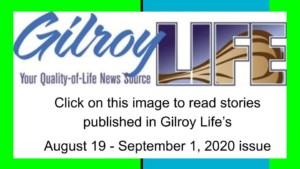 During phase two which is expected to start Sept. 19, volunteers will cover cracks and holes in the wall. During this phase, the scaffolding will be put up and the outline of the images will be transferred onto the wall. In the third phase the artists will paint the mural. During the final phase two more layers of the mural shield liquid will be put on and there will be a site clean-up.
During phase two which is expected to start Sept. 19, volunteers will cover cracks and holes in the wall. During this phase, the scaffolding will be put up and the outline of the images will be transferred onto the wall. In the third phase the artists will paint the mural. During the final phase two more layers of the mural shield liquid will be put on and there will be a site clean-up.
Each phase is expected to last a couple of weeks except for the application of the paint, which will take about three months.
Romo will be leading the repainting of the mural. He will guide new artists Joey Castañeda, Johnny Nuñez along with six younger generation intern artists which include Franco.
“We want to bring Ray Romo from Hawaii. He proposed that we wait until September because of COVID-19,” Franco said. “Repainting the mural is also about restoring the relationship of all the original artists.”
Preserving Chicano murals is a way to preserve Hispanic history. Chicanos have always used public art to speak on history and what really happened, Franco said. He encourages Gilroy’s Latino community to support and be involved in the preservation of these murals.
Once the mural’s restoration is finished, the volunteers will plan a ceremonial celebration and procession to arrive at the Tacos Del Guero restaurant, located in the building where the mural is located on the backside. One idea is to invite danzantes (Aztec-style dancers) from throughout the region who will lead the blessing.
The procession will most likely start at San Ysidro Park east of downtown Gilroy. That’s where the first mural that was restored by CARAS is located. It will then go into South Valley Middle School where another mural was restored, and finally end at the La Piedra del Sol mural. The entire community will be invited.
Latino-themed murals in California have been disappearing, Gamboa said.
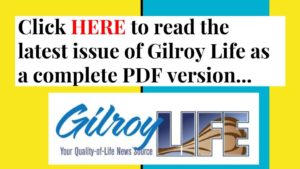 “A community’s art serves as a reference point for generations and memories,” he said. “Culture is not static. It adjusts and adapts, so the preservation of these murals is a preservation of history.”
“A community’s art serves as a reference point for generations and memories,” he said. “Culture is not static. It adjusts and adapts, so the preservation of these murals is a preservation of history.”
Murals like La Piedra del Sol serve to preserve history for future generations.
“It’s emotional for me to see it come back to life,” said Pedro Dimas, a volunteer artist. “Growing up and seeing it here and being part of restoring it, it’s exciting starting the next generation, the next step for our younger kids and young artists.”
Guillermo Aranda, one of the original artists, said it is important to preserve history in a community through public works of art.
“Art, especially murals, document these moments in time,” he said. “In preserving this mural, we are documenting our existence, educating our communities, and we are preserving our history. This mural is history and we need to preserve it.”
- Guest column by Tim Davis: Two Gilroy nonprofits join forces to help those in need - April 17, 2024
- Your Retirement … with Marisa Otto: Do you know how your retirement income is getting taxed? - April 17, 2024
- Guest column by Jaci Muro: Gilroy Foundation supports young people with college scholarships - March 30, 2024
